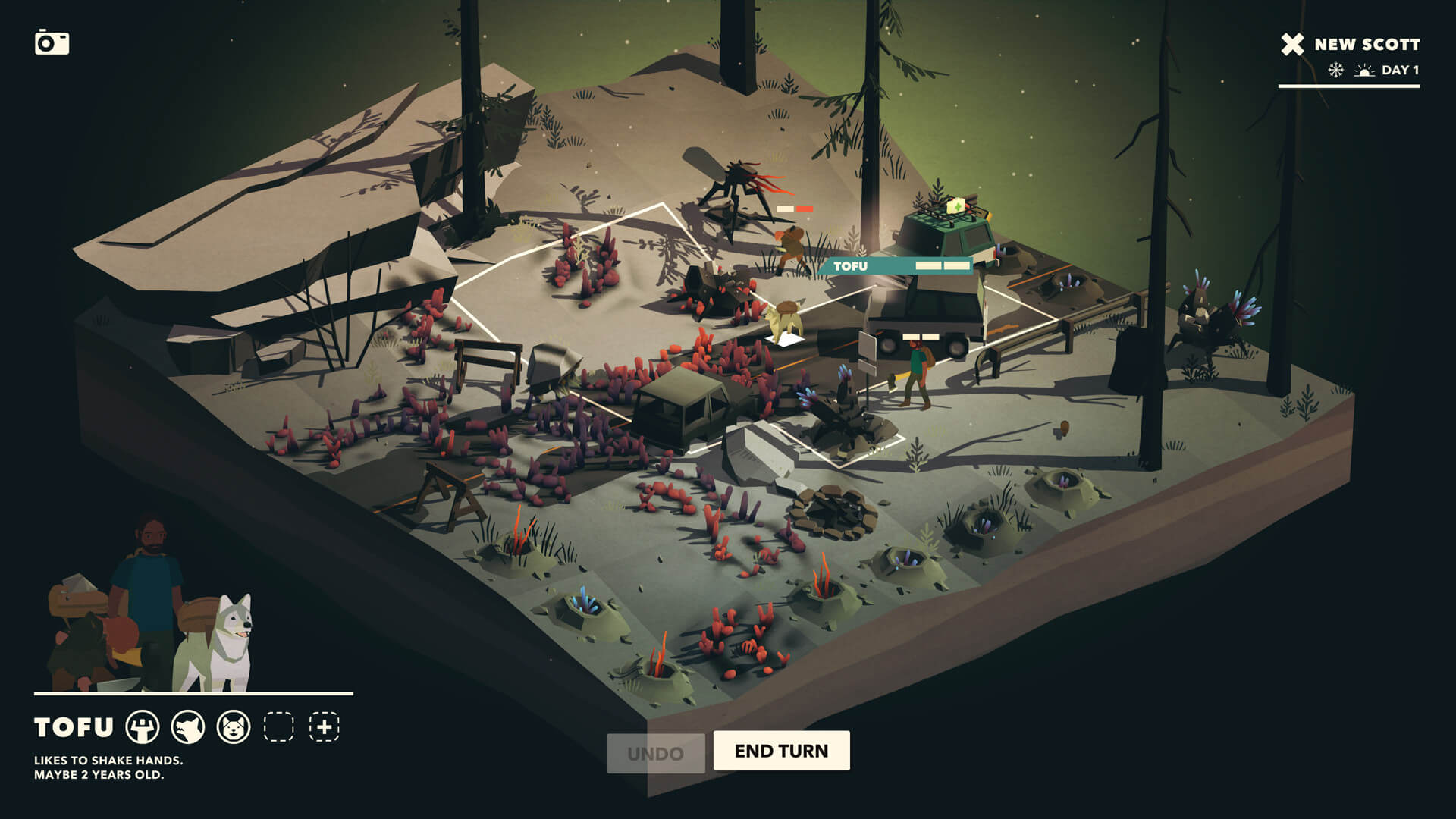Overland is a turn-based survival roguelite that sends you on a fleeing coast-to-coast roadtrip set in post-apocalyptic America. The cause and scope of this apocalypse is unknown, upon first load of the game. Nor why it is you need to embark on this roadtrip at all, or what is at the end. All that matters is that you need to make it to the next tick on the map, the details may fill themselves in as you go – true survivalist mentality.
Armed with a map and a general sense of which way is West, the player makes his way from stop to stop based on the sparse information on the map and what supplies are needed to continue on. Each stop is a single slab of gridded, tactical land, with the road running down the center. Slabs are randomly generated and will include structures relevant to its location, native plant life, sometimes cars levitating lengthwise and other oddities, and, of course, all those squishy, sloshy, clicky monsters. All of this is rendered in emotive and attractive chromatic color scheme and art style.
But don’t let the pretty veneer fool you into complacency. Overland is king bastard difficult – perhaps needlessly so, as we’ll discuss below. Its vignette-styled humanity and compelling strangeness are matched only by the claustrophobic choke-hold with which it often grasps you.

A typical run begins on the ‘East Coast’. Day by day, you take your starting character (who is also random) to different stops and scrounge as many supplies that you can carry and store. Often you come across other humans or dogs. Sometimes a new person will join your cadre, making scrounging and defense easier. Other times, a stranger will, among other things, try and skirt around you and take off with your car, leaving you high and dry. Dealing with humanity is just another element in each encounter on the map.
The major obstacle to each stop are those pesky monsters. Simply eliminating them one-by-one would be too easy, of course. This is survival! Nothing is easy… except dying. No. Your victim lets out a squealing cry and, in response, two mounds elsewhere on the field bulge with tentacles and other moist offal. It’s a mechanic that Overland utilizes to create its reality and impose tough decisions.
Portable radio boxes can be used as decoys. Portable generators can be used likewise. Thumping a monster over the head with a pipe or busting down a wooden barrier with a fire extinguisher. Even the very footsteps of your characters attract attention.

This acoustic call-and-response can create a dynamic playing field, but sometimes it doesn’t. The death knell of a monster will cause ripples, but the throaty rumble of a car engine won’t. Various debris that rains in from off-screen and slams onto the ground won’t either. On the flip side, say I want to remain still so as NOT to attract attention. At the end of turn, the game will still make it as though I am creating vibrations even though I didn’t budge.
Indeed. The overall playing field of each encounter is, by design, confined and often crowded. Because of this, Overland creates a confusing world of what interactions are gamey and what interactions are logical and ‘real’.
Which begs the question: What level of realism is Overland trying to achieve with its mechanics? On the battlefield, gasoline can be poured upon something. That gasoline can be ignited. The wind, be there any, can then fan the flames into adjacent tiles. But, if a monster corpse is blockading the last tile on the field, impeding your escape, you cannot use your car to push it off screen (like you can anywhere else on the field), even though, abstractly, there are thousands of miles of empty road space ahead.
This needless sense of constriction occurs elsewhere in the game. For example, in the downtime in between encounters.
In between battlefields the game treats us to a brief glimpse of humanity in this post-apocalyptic world. Sitting around a campfire, your characters will engage in brief dialog with one another, comments that are triggered by the events of the previous encounter and about what lies ahead. It is a much-needed respite, especially after stressful encounters.

But this is pretty much all that happens – No other gameplay is available, other than selecting the next destination on the map. This is another restriction (or oversight?) in design that makes the game frustratingly and needlessly over difficult.
Quick anecdote:
When the characters exit the car and walk to the campfire, they are carrying whatever item was last in their possession during the previous encounter. One of my characters who had sustained damage limped to the campfire carry a medkit. He told his fellow survivors, “We need to look for a medkit”. Nevermind the fact that he placed one on the ground right beside him. More critically is my inability as the player to use that medkit sitting right beside him in these moments of respite in preparation for the next encounter.
If I am anticipating that the next encounter will occur under the darkness of night, I would like to be able to swap out the car rack for the light rack BEFORE arriving – not when I pull up and have to spend an already-sparse AP points. And even then, the map illustrates that hundreds of miles are traveled between each encounter. That is an awful lot of time, in the abstract, that could be utilized to prepare for the next encounter.
This may all seem nitpicky, or you, dear reader, may also see the fundamental hole that gapes at Overland’s center. Perhaps this is why the game has received such polarizing feedback and reviews.
Overland can be enjoyed on its surface merits. It is a stylish, humane and sober turn-based survival game. It is a story generator that forces tough, desperate decisions. It has infinite replayability and is catnip for achievement hunters. But I see a game that can do more, even within its confined spaces and limited narrative.








2 thoughts on “Overland – Review”